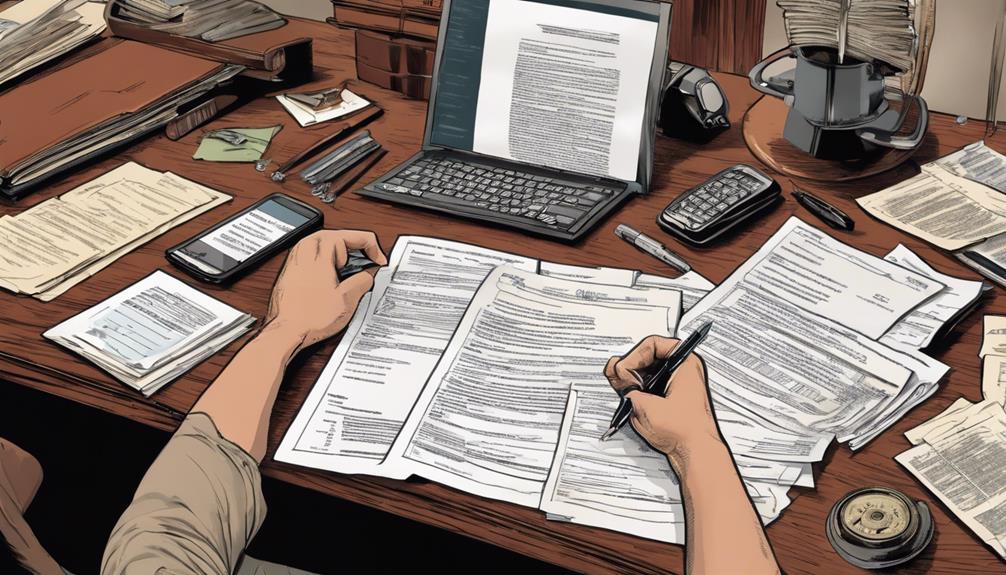Navigating the complexities of divorce in Texas can appear overwhelming, but our comprehensive breakdown simplifies the process step by step. From submitting the initial petition to obtaining the final divorce decree, each stage necessitates thoughtful consideration and legal comprehension.
However, there are crucial aspects such as asset division and child custody arrangements that demand attention. Stay with us to uncover insider tips and practical advice that can make this challenging journey more manageable and less overwhelming.
Key Takeaways
- Insupportability and fault-based grounds influence divorce proceedings in Texas.
- Accurate petition filing, notice provision, and spouse's response are critical steps.
- Communication and compliance with the divorce decree are essential for finalizing the process.
- Understanding Texas Family Law requirements ensures a smooth divorce journey.
Grounds for Divorce in Texas
Let's dive into the different grounds for divorce in Texas to understand the options available to couples seeking to end their marriage. In Texas, couples have the choice of pursuing either fault-based grounds such as cruelty, adultery, felony criminal conviction, and abandonment, or the no-fault ground of insupportability.
Insupportability is the most common ground for divorce in Texas, enabling couples to end their marriage without assigning blame to either party. On the other hand, fault-based grounds require proving specific wrongdoing by one spouse towards the other.
Understanding the distinctions between fault and no-fault grounds is crucial when contemplating divorce in Texas, as it influences the legal process and potential outcomes. Texas law offers flexibility by recognizing both fault and no-fault grounds, providing couples with various paths to dissolve their marriage.
When filing a petition for divorce, selecting the appropriate grounds is a significant decision that can impact the proceedings ahead.
Filing the Petition for Divorce

Filing the petition for divorce in Texas marks the official commencement of the legal process, signaling the beginning of divorce proceedings. When filing the original petition for divorce, it's essential to follow the specific requirements set forth by Texas Family Law.
Here are four key steps to consider during the filing process:
- Prepare the Petition: Work with your attorney to ensure all necessary information is included in the petition, such as the grounds for divorce and details about the marriage and any children involved.
- File with the District Clerk's Office: Submit the completed petition to the district clerk's office along with any required forms and the filing fee. This action officially lodges your case with the court.
- Receive a Case Number: After filing, the court assigns a unique case number to your divorce proceedings. This number helps track the progress of your case within the legal system.
- Ensure Accuracy: Properly completing and filing the petition is crucial. Mistakes or omissions can delay the process, so attention to detail is vital.
Providing Notice to Your Spouse
Providing proper legal notice to your spouse is a critical step in initiating the divorce process in Texas. This ensures that they are informed about the divorce proceedings and can respond appropriately. In Texas, the respondent must be served with divorce papers or sign a Waiver of Service to acknowledge receipt of the divorce petition. It's important to note that signing a Waiver of Service does not mean the respondent agrees with the allegations in the divorce petition. Merely informing your spouse about the divorce filing is insufficient; legal notice must be served following the guidelines set by Texas law.
To illustrate the options for providing notice to your spouse, we present the following table:
| Method of Providing Notice | Description |
|---|---|
| Serving Divorce Papers | Personally delivering the papers to the spouse |
| Waiver of Service | Spouse signs a document acknowledging receipt |
| Service by Publication | If unable to locate the spouse, notice is published in a local newspaper |
Spouse's Response and Counterpetition

Upon receiving divorce papers in Texas, the responding spouse must file an answer within 20 days and has the option to submit a counter-petition outlining their requests and responses to the divorce issues. When crafting a counter-petition, it's crucial to clearly communicate all claims and desired outcomes to ensure transparency and fairness throughout the divorce proceedings.
Here are four essential points to consider when preparing a response and counter-petition:
- Timely Response: The responding spouse should adhere to the 20-day deadline to file an answer after being served with divorce papers to avoid potential legal consequences.
- Detailed Requests: The counter-petition should articulate the responding spouse's specific requests regarding asset division, child custody, support, and any other relevant issues.
- Court Attendance: It's important for the responding spouse to attend court hearings related to the divorce proceedings to stay informed and actively participate in the legal process.
- Open Communication: Maintaining open communication with legal counsel and the opposing party can help facilitate negotiations and potentially lead to a smoother divorce process.
Obtaining Your Divorce Decree
When finalizing your divorce in Texas, obtaining the divorce decree is a crucial step that solidifies the official termination of the marriage. The final divorce decree serves as the ultimate judgment that marks the end of the legal union within the Texas divorce process.
This legally binding document encompasses vital details such as property division, child custody arrangements, visitation rights, and support obligations. After thorough court hearings and mutual agreements on these important matters, the divorce decree is issued, outlining the rights and responsibilities of each party moving forward.
It's imperative for both parties to comply with the terms stipulated in the divorce decree to ensure a smooth transition post-divorce. This document not only finalizes the divorce settlement but also ensures that all parties involved are aware of their obligations and rights in accordance with Texas state laws.
Obtaining this final divorce decree is a significant milestone in concluding the divorce process and moving forward with your new chapter.
Frequently Asked Questions
What Is the Longest a Divorce Can Take in Texas?
We know that in Texas, the longest a divorce can take is typically around 4 to 12 months, especially for contested cases. Factors like property division or custody issues can extend this timeframe.
How Long Does a Divorce Take in Texas Once Filed?
Once filed, a divorce in Texas typically takes 4 to 12 months to finalize. The mandatory 60-day waiting period is a key factor. The discovery phase may extend the process. Uncontested cases generally resolve faster.
What Are the Steps to a Divorce in Texas?
First, we file a Petition for Divorce in Texas. It's vital to serve the Respondent. We streamline by determining if it's contested or uncontested. We finalize by addressing property, debt, child custody, and support, waiting 60 days as mandated by Texas law.
Why Does It Take 60 Days to Get a Divorce in Texas?
We understand the frustration of waiting 60 days for a divorce in Texas. This cooling-off period aims to prevent hasty decisions, promoting thoughtful choices. Exceptions exist for cases of domestic violence. Patience is key.
Is the Divorce Process in Texas Similar to the Process in Michigan?
The divorce process in Michigan and Texas have some similarities, but also significant differences. Both states require a residency period before filing for divorce, but Texas has a 60-day waiting period after filing, while Michigan has a six-month waiting period. Each state also has different laws regarding property division and alimony.
Conclusion
Navigating the divorce process in Texas is like untangling a complex web of emotions and legalities. It requires patience, resilience, and a guiding hand to help you through the twists and turns.
Remember, just like a skilled navigator, with the right support and resources, you can steer your way towards a new beginning and brighter future. Stay strong, stay focused, and know that you aren't alone on this journey.











